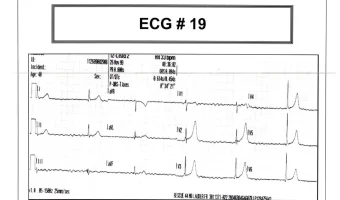12 Lead ECG Basics: Interpretation and Application
About This Course
LEARNING OBJECTIVES
Upon completion of the module, the participant should be able to:
- Identify the coronary blood vessels that supply the heart.
- Identify components of the hearts electrical conduction system.
- Recognize and explain the role of electrolytes in cardiac function.
- Recognize and explain normal and abnormal ECG waveforms.
- Recognize indicators of ischemia, injury, and infarction during acute coronary syndromes.
- Interpret electrocardiogram (ECG) findings on a 12 Lead ECG.
- Identify appropriate treatment considerations for patients with acute coronary syndromes.
CONTENTS FOR THIS MODULE
THE HEART AS A VITAL PUMP
- Anatomy of the Heart
- Low pressure pump
- High pressure pump
CORONARY VESSELS
- Right coronary artery (RCA)
- Left coronary artery (LCA)
- Left anterior descending artery (LAD)
- Left circumflex artery (LCX)
ELECTRICAL CONDUCTION OF THE HEART
- Sinoatrial (SA) node
- Internodal pathways
- Atrioventricular (AV) node
- Bundle of His.
- Left and Right Bundle Branches
- Perkinje fibers
- Ventricles
CHEMICAL BALANCE AND ELECTROLYTES
- Adenosine triphosphate (ATP) as energy source
- Sodium (Na+)
- Potassium (K+)
- Calcium (Ca+)
- Magnesium (Mg++)
THE ELECTROCARDIOGRAM (ECG)
- Lead Placement
- Limb Leads
- Augmented Leads
- Precordial Leads
- Additional ECG Leads
ECG Paper and Measurements
- Size and design of electrocardiogram paper
Waveforms and Complexes
- Isoelectric line
- P wave
- PR-interval
- Q wave
- R wave
- S Wave
- T wave
- U wave
Normal ECG Waveform Measurements
- Measurements
- Amplitude
- Deflection
- Duration
INTERPRETING A 12 LEAD ECG
- Rate
- Rhythm
- Axis Deviation
- Bundle Branch Blocks
- Sgarbossa Criteria – A Tool to Evaluate STEMI Mimics
Ischemia, Injury, and Infarction
- Ischemia
- Injury
- Infarction
Acute Coronary Syndromes
- ST segment elevation myocardial infarction (STEMI)
- Non-ST segment elevation myocardial infarction (NSTEMI)
- Unstable angina (coronary spasm)
- Angina (relieved with relaxation and/or nitroglycerine administration)
REGIONS OF THE HEART
- Septal
- Anterior
- Lateral
- Inferior
- Posterior
- Indicators of distress
Reciprocal changes
- T wave inversion (downward)
- ST-segment deviations or elevation
- Q waves may evolve as wide and deep
- Reciprocal changes (cardiac area opposite of the ST elevation shows ST depression)
Hypertrophy
- Atrial
- Ventricular
ECG ABNORMAILITY CONSIDERATIONS -ECG Findings and Possible Clues for Causes
- Early Repolarization
- Pericarditis
- Left Ventricular Hypertrophy
- Pacemakers
- Potassium
- Calcium
- Digoxin toxicity
- Wellens’ Syndrome
- Brugada Syndrome
Assessment Considerations
- Assessment
Treatment Considerations
- Treatment considerations
- Medications
Assess Your Knowledge
- 12 lead ECG assessment
- 12 Lead knowledge
- Coronary circulation
- Cardiac electrical systems
References:
- How the Heart Works www.webmd.com
- Understanding how your heart functions www.nhsinform.scot
- What are coronary arteries? my.clevelandclinic.org.
- Heart Conduction System (Cardiac Conduction) my.clevelandclinic.org.
- Anatomy and Function of the Heart’s Electrical System www.hopkinsmedicine.org
- Cardiac conduction system medlineplus.gov
- How potassium, magnesium, sodium and calcium imbalances can lead to serious heart complications. https://pharmaceutical-journal.com
- Life-Threatening Electrolyte Abnormalities https://www.ahajournals.org
- Electrocardiogram (ECG or EKG) https://www.mayoclinic.org
- Heart Disease and Electrocardiograms https://www.webmd.com
- Electrocardiogram (ECG or EKG) https://www.heart.org
- Electrocardiogram (EKG) https://my.clevelandclinic.org
- ECG Lead Placement Guide https://www.numed.co.uk
- Recommendations for the Standardization and Interpretation of the Electrocardiogram https://www.ahajournals.org
- The 12-Lead ECG in Acute Coronary Syndromes
- The Importance of the 15-lead Versus 12-lead ECG Recordings in the Diagnosis and Treatment of Right Ventricle and Left Ventricle Posterior and Lateral Wall Acute Myocardial Infarctions. https://www.ncbi.nlm.nih.gov
- Prehospital 12-lead ST-segment monitoring improves the early diagnosis of acute coronary syndrome https://www.ncbi.nlm.nih.gov
- Acute coronary syndrome https://www.mayoclinic.org
- Acute Coronary Syndrome https://www.heart.org
- Heart https://my.clevelandclinic.org
- Picture of the Heart https://www.webmd.com
- What is an abnormal EKG? https://www.healthline.com
- Definition of Early Repolarization https://www.ahajournals.org
- ECG Diagnosis: Acute Pericarditis https://www.ncbi.nlm.nih.gov
- Wellens Syndrome https://www.ncbi.nlm.nih.gov
- Brugada Syndrome https://emedicine.medscape.com
- Left ventricular hypertrophy https://www.mayoclinic.org
- ECG Features demonstrating the Digoxin Effect https://litfl.com
- Digitalis https://www.sciencedirect.com
- ECG Basics: Determining Rate https://www.ncbi.nlm.nih.gov
- Sgarbossa criteria for acute myocardial infarction. https://www.ncbi.nlm.nih.gov
- Walraven, G. Basic Arrhythmias. Pearson Higher Ed, 2014.
- Phalen, T., and B. Aehlert. The 12-Lead ECG in Acute Coronary Syndromes. Mosby Incorporated, 2005.
- Phalen, T., and B. J. Aehlert. The 12-Lead ECG in Acute Coronary Syndromes. Mosby/JEMS, 2018


